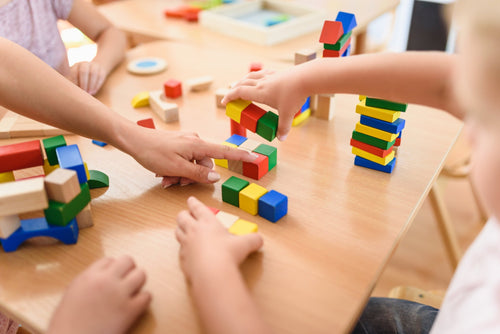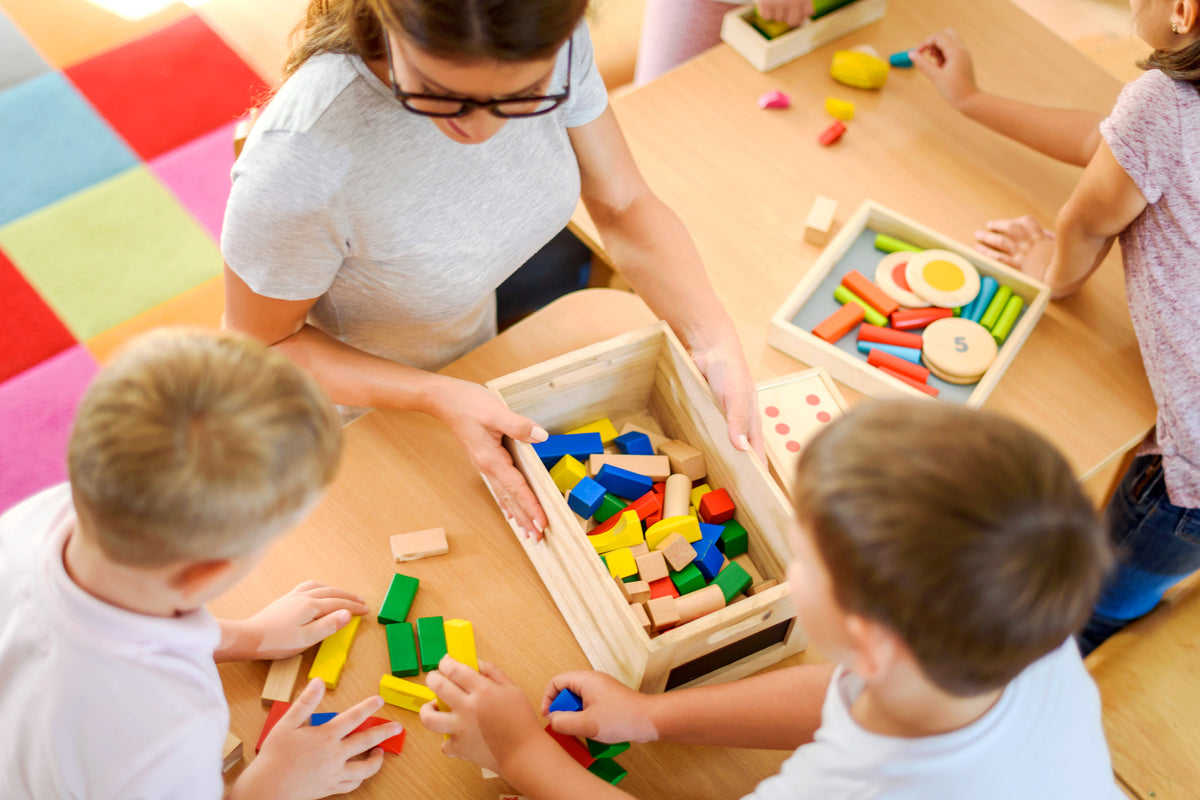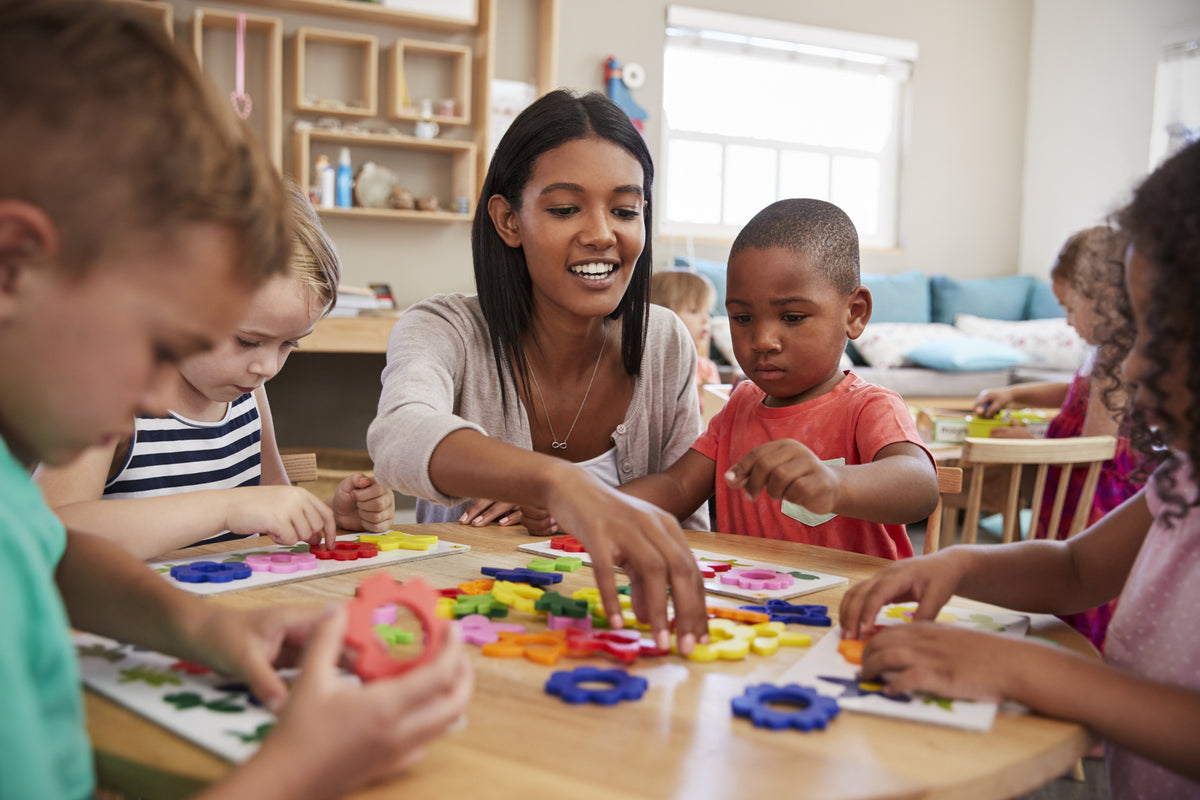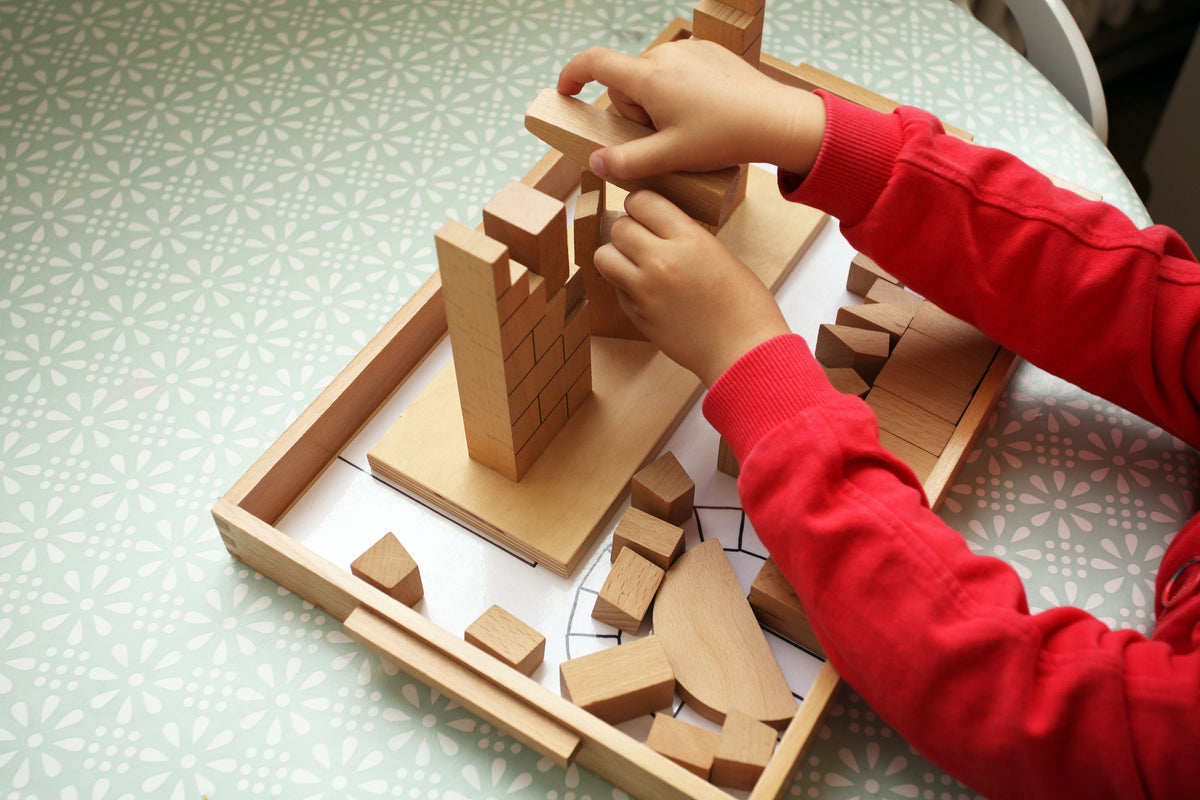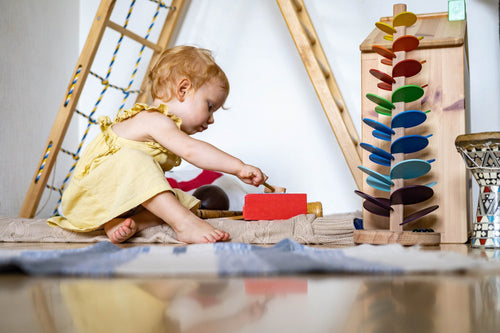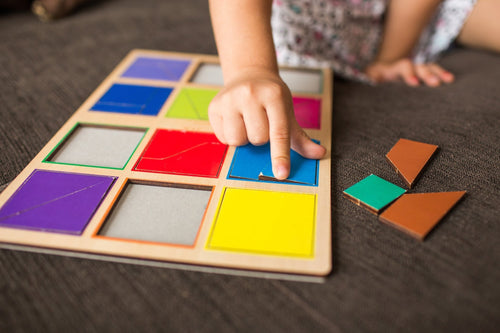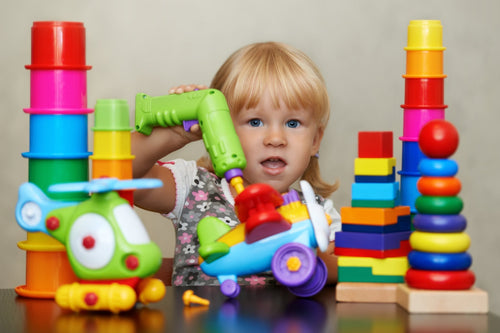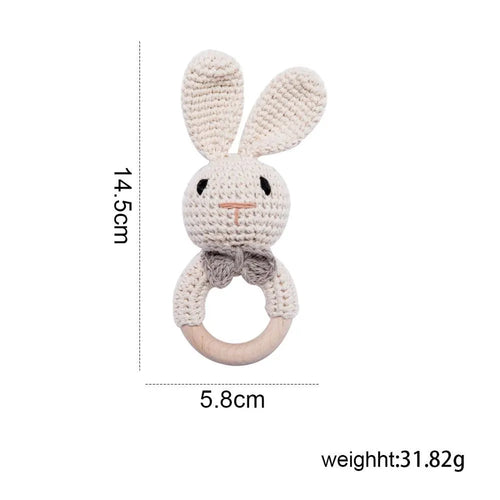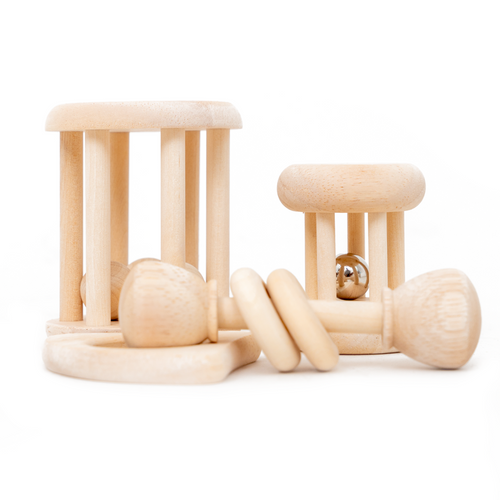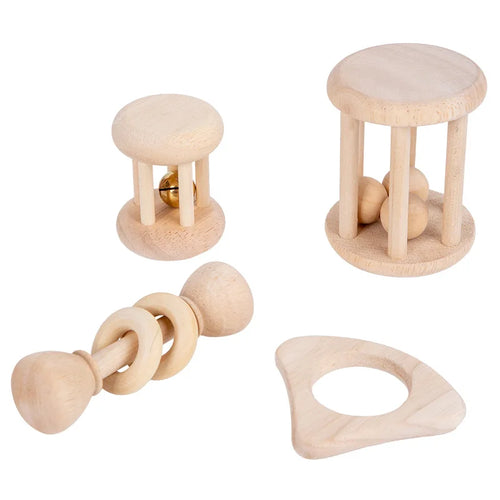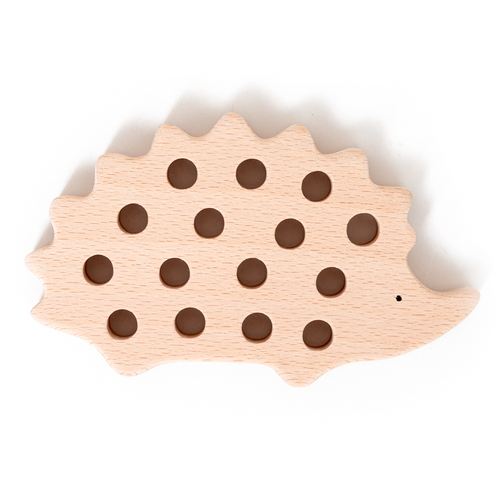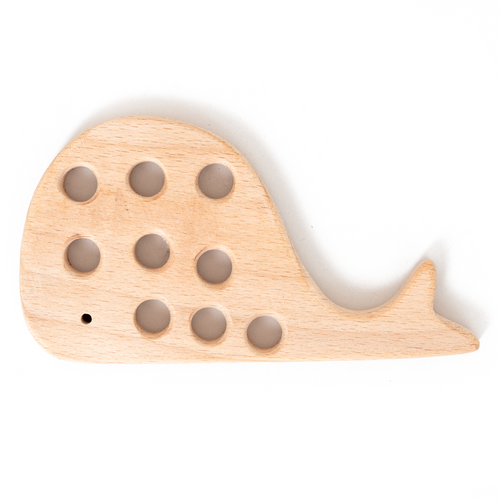
TinyLearns • Parent-first, expert-guided
Quick picks:
- Fine motor: coin-box posting, spoon/pour tray, tweezers transfer, lacing cards.
- Language: real-object baskets, object↔picture matching, three-part cards, sound “I-Spy.”
- Problem-solving: pattern blocks, magnet maze, sequencing cards, balance scale & simple gears.
Why pick toys by skill instead of only by age?
Short answer: Skills (grasp → pincer → tool use; naming → classifying → sound awareness) mature on different timelines. Choosing toys for the specific skill your child is exploring leads to longer focus and faster progress.
- One skill at a time: Fewer features = deeper practice.
- Control of error: Many Montessori activities self-correct so your child doesn’t need constant prompts.
- Daily life connection: Pouring, matching, wiping, and tracing map to independence at home.
Curious how this differs from other philosophies? See Montessori vs. Waldorf.
Which Montessori toys build fine motor skills?

Direct answer: Start with whole-hand work (grasp, peg) → pincer work (posting, bead drops) → tool work (tweezers, eyedropper, lacing). Keep each activity to one tray, one goal.
Fine motor progression
| Stage | Try This (1 Tray) | Why It Works | Scale-Up Idea |
|---|---|---|---|
| Whole-hand grasp (baby → early toddler) | Grasping ring / soft rattle; large-peg puzzles | Strength + bilateral coordination, no flashy distractions. | Smaller pegs; varied shapes |
| Pincer grasp (toddler) | Coin-box posting; bead drop; knobbed cylinders | Short, repeatable motions refine thumb–forefinger control. | Smaller slots; mixed sizes for sorting |
| Tool use (older toddler → preschool) | Tweezers transfer; eyedropper color mixing; lacing cards | Builds precision, wrist stability, hand dominance. | Smaller pieces; pattern lacing; timed transfer |
Explore Montessori and Sensory picks that build fine motor without overstimulation.
Which Montessori toys build language?
Direct answer: Real objects and real images in context, plus short, joyful “conversations.” Move from naming → classifying → sound awareness, always alongside books.
Language progression
| Focus | Try This | How to Present | Next Step |
|---|---|---|---|
| First words (baby → toddler) | Real-object basket (cup, brush, spoon) | Name in routines (“brush,” “cup of water”). Keep it real. | Object↔picture matching cards |
| Classification (toddler) | Sorting trays (fruit/veg; land/sea animals) | Limit to 2–3 categories; pause for the child to respond. | Three-part cards (photo, picture, label) |
| Sound awareness (preschool) | I-Spy initial sounds; sound baskets (/m/ objects) | Keep it playful (5–7 minutes). Follow interests. | Sandpaper letters; moveable alphabet (later) |
Pair activities with high-interest books. For broader context, see What Are Educational Toys?, What Are Sensory Toys?, and What Are STEM Learning Toys?.
Which Montessori toys build problem-solving & executive function?

Direct answer: Use toys with a single clear goal (no auto-solve): pattern blocks, sequencing cards, magnet mazes, balance scales, and simple gears. These invite planning, testing, and checking—without adults stepping in too fast.
Logic ladder (planning → flexibility)
| Age Band | Examples | Exec-Function Targets | Collections |
|---|---|---|---|
| Toddler (12–36m) | Shape sorter; first peg puzzles; coin-box | Attention, persistence, cause-and-effect | Montessori |
| Preschool (3–6y) | Pattern blocks, magnet maze, simple gears, balance scale | Planning, sequencing, flexible thinking, error-checking | STEM |
What about sensory input and self-regulation?
Direct answer: Many Montessori tasks are predictably rhythmic (pour, scoop, wipe)—great before seated work. When more input helps, try:
- Heavy work: carry books, push laundry basket, scoop beans.
- Rhythm: hand drum patterns, marching, clapping games.
- Calm nook: small tent, soft book basket, simple visuals.
Learn more: What Are Sensory Toys?
How do Montessori toys compare to regular toys (by skill)?
| Skill | Montessori Approach | Typical Regular Toy | Likely Outcome |
|---|---|---|---|
| Fine motor | Posting, pouring, threading—single goal | Multi-feature electronic toy | Longer focus vs novelty-seeking |
| Language | Real objects/photos + real talk | Talking alphabet toy | Richer vocabulary in context vs passive exposure |
| Problem-solving | Puzzles/mazes with no auto-solve | Apps that auto-correct instantly | Active planning & error-checking vs passive feedback |
Best Montessori toys by age × skill (quick matrix)
| Age Band | Fine Motor | Language | Problem-Solving | Browse |
|---|---|---|---|---|
| 0–12 months | Grasp ring; spinning drum; large-peg puzzle | Object naming; faces/mirror; high-contrast cards | Soft blocks; cause-and-effect play | Montessori • Sensory |
| 12–36 months | Coin-box; spoon/pour trays; busy board | Object↔picture matching; first classification | Shape sorter; 2-step sequencing | Montessori • Books |
| 3–6 years | Tracing boards; lacing; tweezers transfer | Three-part cards; sound games; themed non-fiction books | Pattern blocks, magnet maze, simple gears | STEM • Language |
Prefer an age-first overview? See Montessori Toys by Age (0–6).
How do I choose and rotate toys for a target skill?

Direct answer: Observe → pick 2–4 trays → model once → step back → rotate when mastered/ignored.
Quick checklist
- Does it isolate one step (post, pour, match, trace)?
- Is everything needed on one tray (independence)?
- Is there built-in self-correction?
- Is difficulty “just right” (not frustrating or trivial)?
Troubleshooting
| If you notice… | Try this |
|---|---|
| 30-second toy-hopping | Reduce to 2 choices; add a small work rug; slow demo once |
| Frustration | Fewer pieces; larger tools; lighter materials (beans → pom-poms) |
| Mess after work cycle | Teach “return to tray”; give parking spots; keep mini broom on shelf |
Set-up help: How to Introduce Montessori at Home.
Do Montessori toys have to be wooden?
Direct answer: No. Wood is common for durability and sensory feel, but fabric and non-toxic plastic can be just as purposeful. The Montessori “test” is simplicity, independence, and real-life relevance—not a specific material.
Philosophy deep-dive: What Makes Montessori Toys Different?
Related TinyLearns guides
- What Are Montessori Toys?
- Montessori vs. Waldorf
- How to Introduce Montessori at Home
- What Makes Montessori Toys Different?
- What Are Sensory Toys?
- What Are Educational Toys?
- What Are Fidget Toys?
- What Are STEM Learning Toys?
FAQ: Skill-based Montessori toy picking
How many toys should be out if we’re targeting one skill?
Two to four. Keep one tray per skill (e.g., one for fine motor, one for language). Rotate when your child masters or ignores it.
What’s the best first fine-motor tray?
A coin-box posting or simple spoon/pour tray—short, repeatable, easy to scale up.
How can I support language without screens?
Use real-object baskets and themed non-fiction books. Speak in clear, concrete phrases during daily routines.
Are puzzles Montessori?
Many are. Choose puzzles that isolate one concept (shape, animal type, parts of a whole) and fit snugly for self-correction.
How do I make this affordable?
Start with household items: two cups + beans for pouring, a shoebox slot for posting, sock/fabric matching. Add durable pieces gradually.
Sources & further reading
- Association Montessori Internationale — What is Montessori Education?
- NIH / NICHD — Early Learning & Development
- CDC — Child Development Milestones
- AAP — Toy Safety Tips

